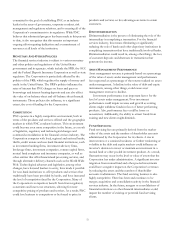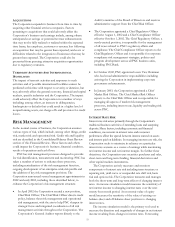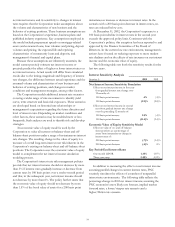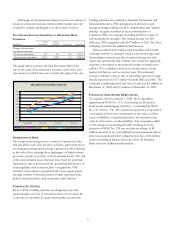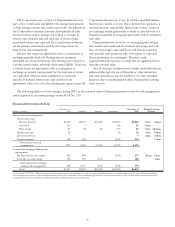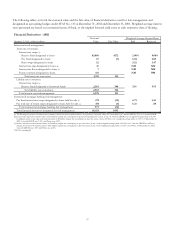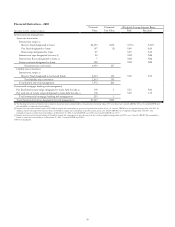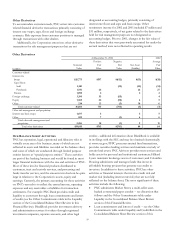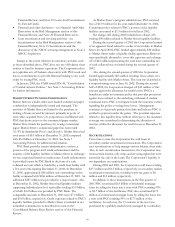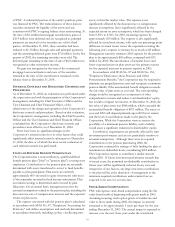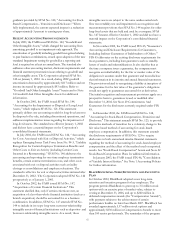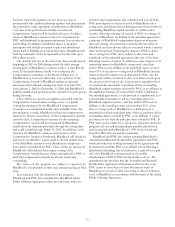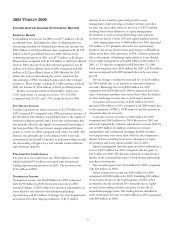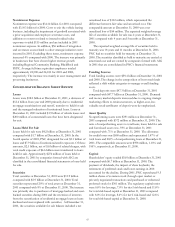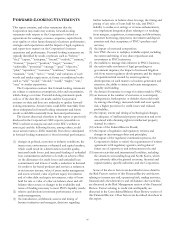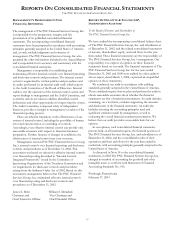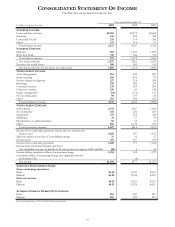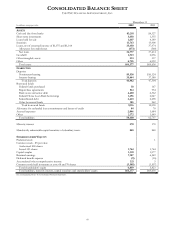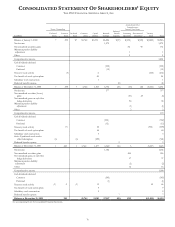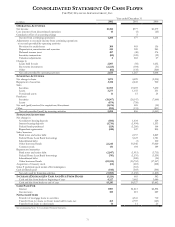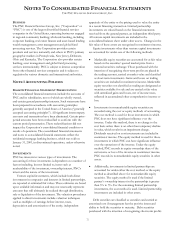PNC Bank 2002 Annual Report Download - page 64
Download and view the complete annual report
Please find page 64 of the 2002 PNC Bank annual report below. You can navigate through the pages in the report by either clicking on the pages listed below, or by using the keyword search tool below to find specific information within the annual report.62
guidance provided by SFAS No. 148, “Accounting for Stock-
Based Compensation – Transition and Disclosure.” When
fully implemented, the current expected impact is a reduction
of approximately 3 percent to earnings per share.
RECENT ACCOUNTING PRONOUNCEMENTS
In July 2001, the FASB issued SFAS No. 142, “Goodwill and
Other Intangible Assets,” which changed the accounting from
amortizing goodwill to an impairment-only approach. The
amortization of goodwill, including goodwill recognized relating
to past business combinations, ceased upon adoption of the new
standard. Impairment testing for goodwill at a reporting unit
level is required on at least an annual basis. The standard also
addresses other accounting matters, disclosure requirements and
financial statement presentation issues relating to goodwill and
other intangible assets. The Corporation adopted SFAS No.
142 on January 1, 2002. As a result, during 2002 goodwill
amortization decreased by approximately $117 million and net
income increased by approximately $93 million. Refer to
"Goodwill And Other Intangible Assets" herein and to Note
14 Goodwill And Other Intangible Assets for additional
information.
In October 2001, the FASB issued SFAS No. 144,
“Accounting for the Impairment or Disposal of Long-Lived
Assets,” which replaces SFAS No. 121. This statement
primarily defines one accounting model for long-lived assets to
be disposed of by sale, including discontinued operations, and
addresses implementation issues regarding the impairment of
long-lived assets. The standard was effective January 1, 2002
and did not have a material impact on the Corporation’s
consolidated financial statements.
In July 2002, the FASB issued SFAS No. 146, “Accounting
for Costs Associated with Exit or Disposal Activities,” which
replaces Emerging Issues Task Force Issue No. 94-3, “Liability
Recognition for Certain Employee Termination Benefits and
Other Costs to Exit an Activity (including Certain Costs
Incurred in a Restructuring).” SFAS No. 146 addresses the
accounting and reporting for one-time employee termination
benefits, certain contract termination costs, and other costs
associated with exit or disposal activities such as facility
closings or consolidations and employee relocations. The
standard is effective for exit or disposal activities initiated after
December 31, 2002. The Corporation adopted SFAS No. 146
prospectively as of January 1, 2003.
In October 2002, the FASB issued SFAS No. 147,
"Acquisitions of Certain Financial Institutions." This
statement clarified that, only if certain criteria are met, an
acquisition of a less-than-whole financial institution (such as a
branch acquisition) should be accounted for as a business
combination. In addition, SFAS No. 147 amends SFAS No.
144 to include in its scope long-term customer-relationship
intangible assets of financial institutions such as depositor- and
borrower-relationship intangible assets. As a result, those
intangible assets are subject to the same undiscounted cash
flow recoverability test and impairment loss recognition and
measurement provisions that SFAS No. 144 requires for other
long-lived assets that are held and used by a company. SFAS
No. 147 became effective October 1, 2002 and did not have a
material impact on the Corporation’s consolidated financial
statements.
In November 2002, the FASB issued FIN 45, "Guarantor’s
Accounting and Disclosure Requirements for Guarantees,
Including Indirect Guarantees of Indebtedness of Others."
FIN 45 elaborates on the existing disclosure requirements for
most guarantees, including loan guarantees such as standby
letters of credit and indemnifications. It also clarifies that at
the time a company issues a guarantee, the company must
recognize an initial liability for the fair or market value of the
obligations it assumes under that guarantee and must disclose
that information in its interim and annual financial statements.
The provisions related to recognizing a liability at inception of
the guarantee for the fair value of the guarantor’s obligations
would not apply to guarantees accounted for as derivatives.
The initial recognition and measurement provisions apply on a
prospective basis to guarantees issued or modified after
December 31, 2002. See Note 29 Commitments And
Guarantees for the disclosures currently required under FIN
45.
In December 2002, the FASB issued SFAS No. 148,
"Accounting for Stock-Based Compensation--Transition and
Disclosure." This statement amends SFAS No. 123, to provide
alternative methods of transition for a voluntary change to the
fair value based method of accounting for stock-based
employee compensation. In addition, this statement amends
the disclosure requirements of SFAS No. 123 to require
disclosures in both annual and interim financial statements
regarding the method of accounting for stock-based employee
compensation and the effect of the method used on reported
results. See "Stock-Based Compensation" herein and Note 22
Stock-Based Compensation Plans for additional information.
In January 2003, the FASB issued FIN 46, "Consolidation
of Variable Interest Entities." See Note 1 Accounting Policies
for further information.
BLACKROCK LONG-TERM RETENTION AND INCENTIVE
PLAN
In October 2002, BlackRock adopted a new long-term
retention and incentive program for key employees. The
program permits BlackRock to grant up to 3.5 million stock
options with an exercise price of market value, subject to
vesting at December 31, 2006, and up to $240 million in
deferred compensation awards (the “Compensation Awards”),
with payment subject to the achievement of certain
performance hurdles no later than March 2007. BlackRock has
awarded approximately 3.37 million stock options and
approximately $130 million in Compensation Awards to more
than 100 senior professionals. The remainder of the program


